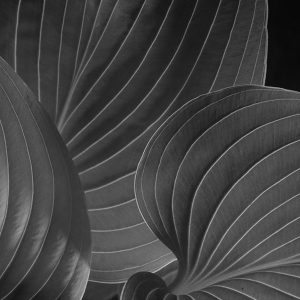
Hosta leaf patterns in black and white

Hosta leaf patterns in black and white
I had my slides all mounted and ready to ship a week ago. They had been titled, scanned, and fit into (seamed) sleeves. The problem was, they wouldn’t fit into the Dragon Folio box. It was then I noticed that every other slide in the box was mounted in cardboard. Mine were in plastic mounts. Instead of remounting my original four, I decided to save them for the next loop of Folio A. I mounted four new selections, all in cardboard mounts;
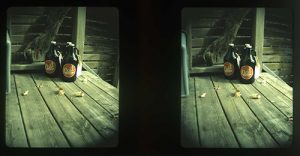
“Same As Surly Curs” – the title is a crossword puzzle type of clue (the answer is “growlers”). This was shot during what is possibly the least-known photography celebration; “World Toy Camera Day”, observed on the third Saturday of October. I employed a Holga 120 CF stereo camera with add-on wide angle lens attachments (which add vignetting) and a roll of Provia 400 to shoot a few photos on my deck to honour the occasion. Developed in a Jobo processor in my basement using Tetenal Colortec E6 chemicals.
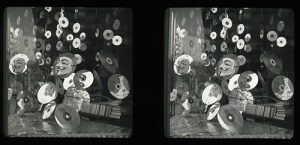
“DISC-guises” – this image is one I originally considered a focal point failure, but I revisited it, mounted the chips and decided to submit it anyways. It was shot with a TL-120-1 on APX 100 film, and sent to dr5 for Dev1 processing.
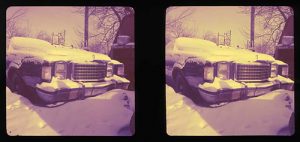
“How To Winterize Your Vehicle” – I’m fairly certain that this was captured on one of a handful of trips to Mclean’s Auto Wreckers in Rockwood. When I feel the urge to go explore this vast car graveyard, I call ahead, then I bake something with beer for the Mclean’s proprietors to gain my admission – chocolate stout cake, raspberry beer blaster cookies….you get the idea. It’s either bake them something beforehand or share your photos with them afterwards, and sharing photos is just too much damned work! Shot with a TL-120-1 on Fuji NHP 400 negative film, then cross-processed in Argentix (Arista) E6 chemicals using a Jobo processor in my basement.
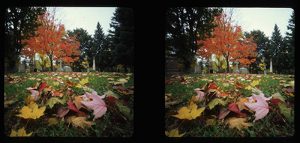
“The Jazz Standard” – this title is also a crossword puzzle type of clue (the answer is “Autumn Leaves”). This is a pinhole image, and I captured this just prior to Hallowe’en 2018, using one of Todd Schlemmer’s terraPIN Oskar^2 stereo pinhole cameras on a GorillaPod. I seem to recall that the exposure was somewhere around the 1 min. 32 sec mark. Todd’s cameras are 3D printed using environmentally-responsible materials. This roll of Fuji RVP was developed in a Jobo processor in my basement using Tetenal Colortec E6 chemicals.
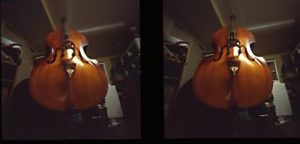
![]()
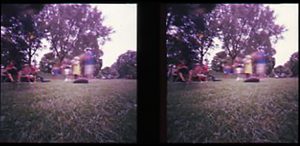
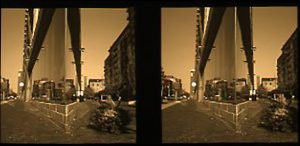
Sepia images and Pinhole images just naturally go together. Okay, so maybe they don’t, but these are the images that I’ve selected for this go-’round of the Folio.
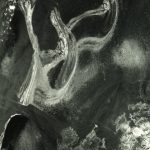 The Mendenhall is magnificent from a distance. It is spectacular if you can get up close and personal.
The Mendenhall is magnificent from a distance. It is spectacular if you can get up close and personal.
The ice has layers and threadsof dirt and sand which were washed down and embedded in the originating snow. As the glacier is pushed down the valley, the face melts away and the embedded dirt, sand, sticks, leaves, and silt are released. You should be suspicious of anyone selling you “crystal clear glacier ice” 🙂
Tripod mounted TL120-1, DR5-processed HP5
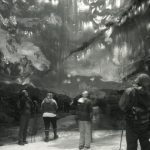 There are often caves in and under the Mendenhall glacier. In the winter, when the lake is frozen and travel is easier, there are often many folks visiting.
There are often caves in and under the Mendenhall glacier. In the winter, when the lake is frozen and travel is easier, there are often many folks visiting.
On this particular day, I set my camera up and loitered in the corner. The first set of bystanders is always very self conscious and makes explicit efforts to stay away and not “spoil” the shot. By simply loitering with a long cable release (while wearing warm clothes), I out-wait them and they are replaced. The newcomers ignore me as part of the landscape. Then I can trip the shutter, and reach over to advance the film.
Tripod mounted TL120-55. DR5-processed HP5
Matt hasn’t shot alot of film lately, but still wanted to participate in this loop of the folio. Since members of Folio B haven’t seen any of his images, I suggested that I be allowed to pick out four slides from his past body of work for submission to the Folio. He agreed and asked me to curate. My image descriptions will also serve as my comments. Matt usually shoots with Fuji Provia 100F film (not for “Ferry Dock” of course), and a Sputnik. He has also owned two incarnations of the TL-120 – a TL-120-1, and a TL-120-55. As these selections span seven years, I’m not sure which camera or film was used for each one.
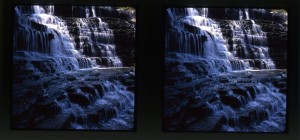 “Albion Falls” – captured in Hamilton, Ontario, Summer 2004 – I selected this shot for its composition, varied lighting, depth and detail. That particular area of Hamilton / Ancaster is home to a great number of waterfalls. Matt has captured a lovely rendering of one of them.
“Albion Falls” – captured in Hamilton, Ontario, Summer 2004 – I selected this shot for its composition, varied lighting, depth and detail. That particular area of Hamilton / Ancaster is home to a great number of waterfalls. Matt has captured a lovely rendering of one of them.
 “Pretty Women” – Misha, Sandra and Kim, in Matt’s backyard, 2009 – I selected this image simply because I think it’s a great portrait. You can invent your own back stories for the expressions on the women’s faces. Thought went into the stereo composition – there are foreground elements, the main subjects, and a slightly soft background which serves to highlight the main subjects.
“Pretty Women” – Misha, Sandra and Kim, in Matt’s backyard, 2009 – I selected this image simply because I think it’s a great portrait. You can invent your own back stories for the expressions on the women’s faces. Thought went into the stereo composition – there are foreground elements, the main subjects, and a slightly soft background which serves to highlight the main subjects.
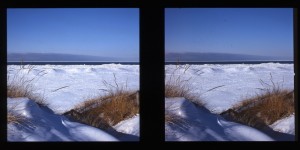 “Lake Huron” – captured in Pinery Provincial Park, 2010 – As you may know, it’s not easily to properly expose snow. Especially when it’s 30 below, ho ho ho. I like the repeating hilly motif from foreground to mid-shore.
“Lake Huron” – captured in Pinery Provincial Park, 2010 – As you may know, it’s not easily to properly expose snow. Especially when it’s 30 below, ho ho ho. I like the repeating hilly motif from foreground to mid-shore.
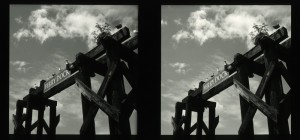 “Self Titled (Ferry Dock)” – captured in Vancouver’s Ferry Market 2011 – I selected this image for the wonderful use of the dr5 process, the composition, subject matter and the sharpness of detail.
“Self Titled (Ferry Dock)” – captured in Vancouver’s Ferry Market 2011 – I selected this image for the wonderful use of the dr5 process, the composition, subject matter and the sharpness of detail.
Matt died of cancer October 1, 2016. His generosity and support for his friends will be missed. [JRT October 3, 2016]
Before I forget, thanks to Steven Lederman for scanning these pictures for me! I think this was Delta 100 and processed by DR5.
This picture was taken on the chikanishing trail. Spoiler for me is the right image has a reflection or something that once you see it (sorry!) it becomes very distracting.
I wonder if it’s possible to touch up the emulsion to fix this….
Talk about harsh lighting! I think this went around in the IMF3D folio. Some people liked it, some people really didn’t like it. This was taken with my Spud a long long time ago.
Taken with the TL-120 in Pennsylvania on a camping trip with James Mutch. There are a lot of waterfalls in a small area here. At one waterfall J and I watched a pro photographer taking a classic fall colour waterfall shot. His assistant held a maple branch with red leaves in front of the camera while he took pictures.
Taken with a TL-120 on the same trip to Vancouver a few years back. At that time I posted a picture of my nephew on his roller skates. I’m hoping this is a new image to this folio.
Looking down into the pits of hell, are those the screams of your political opponents you hear? Maybe it’s only last night’s burritos talking.
Regardless, I don’t want to be pitched over the edge.
TL120-55, Ilford HP5, DR5 processing (Yes, I typo’d the title on the mount, but given the scarcity of mounts I didn’t feel the need to remount in a clean one.)
This image has been a while in the making. After reviewing my attempts at winter landscapes, I went out to try to do some things differently. I loaded a pack, took the first sunny day off work, and headed out to Cowee Creek where I knew I’d have moderate snow, free-standing trees, and a dramatic backdrop lit by the low afternoon sun. The film was exposed in February of 2014, processed by DR5 in May, and mounted in February of 2015.
To try to force the back of foreground tree trunk out of the shadows, I used a couple of Vivitar 285 flashes. One weak one firing forward (and slightly right) from just below the camera, and a stronger one coming from the far left.
While I think my concepts were correct, I fell short in the execution. This was the last roll of the day. It is a tested characteristic of my camera that the shutter timings start to drift at low voltages. By the time this roll was exposed, the batteries in the TL120 were failing in the cold and the right side was under exposed.
Approximately once a year dr5 offers “Dev2” service, which is basically sepia processing. The only Fuji film that can be processed in dr5 is Neopan 400, and at that only in Dev2. When dr5 announced the limited availability of Dev2 last year, I grabbed the only roll of Neopan 400 I had, and drove out to the airport. Behind a strip mall row, beside a dilapidated parts factory, resided a trio of desecrated automobile shells. This was part of that day’s one roll shoot. Shot with a TL-120 modified with Sam Smith’s 55mm conversion, on the aforementioned film using a handheld meter.
Thanks for allowing me to share my images. I’ve enjoyed your beautiful work
I was inspired by David Lee’s great hyperstereos to try shooting some of my own. My first attempt was from the Mark hotel in San Francisco, My second from a rooftop bar in NYC.
The others are EFKE 25 DR5 transparencies shot at the National Railroad Museum in Wisconsin. We just had a 3rd boy and moved to Long Island. I also started a new job, so we’ve been busy. I wouldve liked to attend the NSA this year, but maybe some time soon. If any of you are in NYC drop me a line, perhaps we can meet for some mf3d or other photography
Thank you,
Nik Sekhar
This is my brother-in-law, Gordon, and yes ladies, he’s single! This is another shot from last year’s beer run. Gordon plays an international online tank game, so we stopped on our way to the beer store in Vermont to shoot an avatar image for him. I captured a few shots with a Fuji W3, and then I bracketed some exposures with the Stereo Samulette.
I have another version of this shot that I like slightly better, as the background is sharper and there’s an American flag present, but the setting sun washed out some of Gordon’s features and his pose was more rigid, so you get to see this one instead.
I realize there’s a scratch or some sort of anomaly on the left film chip.
This was handheld, shot on HP5 processed by dr5 – I think the f-stop was 16, 1/100th of a second handheld, and the distance and hyperfocal estimation was guesswork (there’s no through-the-lens focusing on this camera).
My brother-in-law Gordon is a bière connoisseur. He makes regular pilgrimages to Vermont to frequent a specialty store there that stocks micro-brews from around the globe.
Last year I decided I’d accompany him on one of his beer runs to Vermont via the quaint Quebec countryside so that I’d have an opportunity to shoot with my folding medium format camera. If I did all the driving, I’d have control over where we stopped for a photo op. I am pleased with how the camera performed. I enjoy the vintage feel of this shot, marred only by the snout of the more modern vehicle peering out from the rear of the truck bed.
This scene reminds me of the subject matter that my late friend Earl Bennett was attracted to when he painted. He studied with Thomas Hart Benton in the 1930s and for the most part painted works that dealt with small town, mid-Western life.
This image was shot on HP5, processed by dr5. I wish I could say the shutter speed was 5 and the f-stop was 5, but no such luck. The f-stop was 32, handheld at 1/100th.
The camera was created by Sam Smith, fusing together two 1950s-era AGFA Isolette II folders. It has AGFA’s intermediate-level f4.5 Apotar lenses on S-Prontor shutters. When folded shut, it fits into a jacket pocket. It’s resplendent in faux ostrich skin. I wanted to name it “The AGFA Stereo Smith-O-lette”, but Sam liked the sound of “Sam-O-lette” better. For some reason, when I say “Sam-O-lette” I think of Frank Zappa’s “Camarillo Brillo” and the lyrics; “She had a snake for a pet, and an amulet…”, so since Sam told me to name this camera “whatever sounds good”, I’ve named it “The Samulette”.
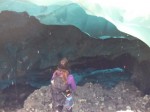 Today, we’re going back to the ice but we’re not going to move much once we get there. All of the images here were made within 50-feet of each other. The subject is a fairly stable ice cave. I say fairly because it was created by an active creek so there is water flowing into it. The ground is mud, silt, ice, and gravel and is sliding into the cave and under the glacier. The ceiling is made of ice and is full of mud, silt, and gravel and is falling onto the floor. While I was working, some nice ladies stopped in to visit the cave. I used my Fuji to get a set-the-scene snapshot.
Today, we’re going back to the ice but we’re not going to move much once we get there. All of the images here were made within 50-feet of each other. The subject is a fairly stable ice cave. I say fairly because it was created by an active creek so there is water flowing into it. The ground is mud, silt, ice, and gravel and is sliding into the cave and under the glacier. The ceiling is made of ice and is full of mud, silt, and gravel and is falling onto the floor. While I was working, some nice ladies stopped in to visit the cave. I used my Fuji to get a set-the-scene snapshot.
Just inside the cave, the layers of the ice are obvious. The younger ice is above, the older ice is denser and is funneling the melt water out to the edge. The running water has carved a Deep V in the ancient ice. The mud and sand is trapped between the layers of ice and is being washed down and dropped on the floor. When working under the ice, the water running down your back is really mud (of various dilutions).
A little to the right, and closer to the ice, In the Groove better shows the layers in the ice and the sand and silt trapped between them. We can also see melt water pouring in to join the creek farther inside the cave.
Farther in the cave but looking a little up, we can see Below the Surface(BW). There is sand and silt embedded inside the ice, and the layers are evident from the back just as well as the front. (Now’s a good time to wish we had carried a helmet with us. The roof is melting, remember?) Finally, we can move a little farther in and get in close. That sand in there has been trapped in the ice for a couple hundred years. It’s just itching to get out so it can slide down into my camera.
 Below the Surface (BW) |
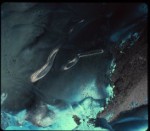 Below the Surface |
All images were created with a tripod mounted TL120-1. I don’t record exposure times but the fastest time used was 1 second. They were shot on Provia 100F, Provia 400X, or Ilford HP5.